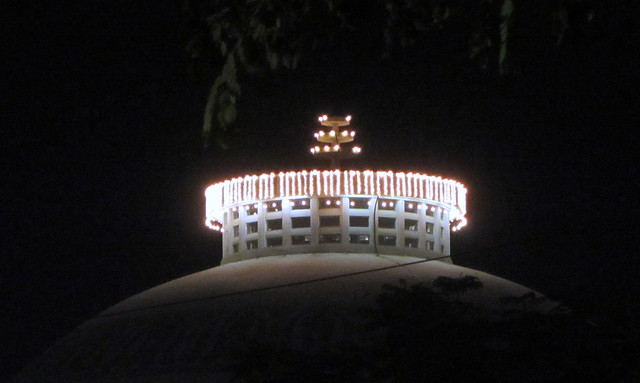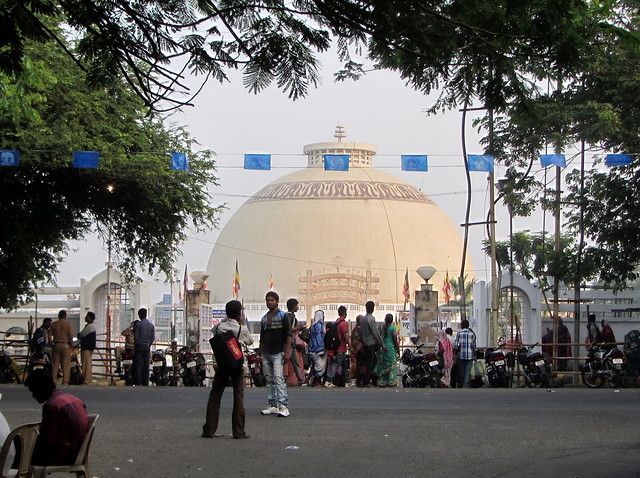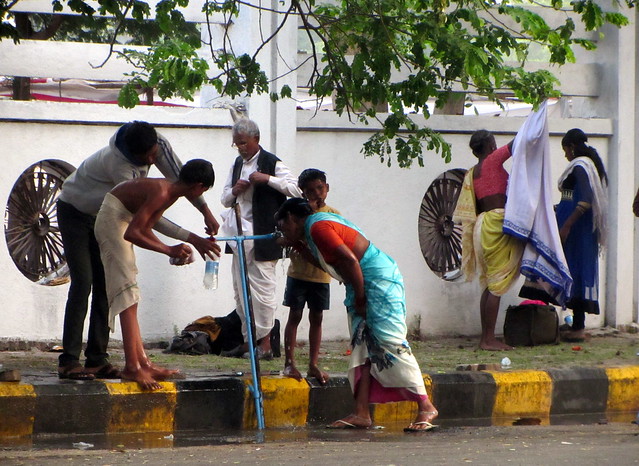By Nivedita Khandekar
Nagpur (Maharashtra): Hemlata Sontakke, 60, was too young to remember the epoch making event she had attended with her family in 1956. But that has not stopped her from remembering it every single day of her life as it was indeed a life-changing experience for lakhs of those who attended the ceremonial Dhamma Deeksha that day.
On the Dussehra day that year – October 14, 1956 – one-year-old Hemlata and her entire family had joined hundreds and thousands of others to accept Dhamma Deeksha (converting to Buddhism) led by the architect of the Indian Constitution and Dalit stalwart Dalit leader Dr Babasaheb Ambedkar. The day since has been known as ‘Dhamma Chakra Pravartan Din’.
The vast ground that was witness to the momentous occasion was named as Deeksha Bhoomi and several years later, a massive stupa, on the lines of famous Sanchi Stupa – was constructed as a memorial, which now occupies a pride of place here.
Hemlata, originally from Nagpur, shifted to Aurangabad after marriage. But every time she comes to Nagpur, a visit to Deeksha Bhoomi is a must. Clutching photos of Dr Ambedkar and Gautam Buddha in her hands, the retired government school teacher said: “I am happy and proud that although very young, I was present there. It is hard to explain the impact of this event on our lives. Dr Ambedkar showed us the light, the path of knowledge.”
Visiting the Deeksha Bhoomi on the eve of Dussehra, Wednesday, October 21, 2015, her face bathed in joy, she said, it is more than a ritual to visit this place. “This is a pilgrim place, something that brings peace for all.”
Hemlata Sontakke clearly is not the only one to believe this if the surging crowds are any proof.
Deeksha Bhoomi
Deeksha Bhoomi is spread over almost four acres. Dr Ambedkar Smarak Samiti constituted after the mass leader’s death had decided to build a stupa as a memorial for the mass conversion ceremony. The construction of the main stupa continued for several years due to various issues but it was finally completed and inaugurated in December 2001. The monument is almost 120 feet high and the stupa dome too has 120 feet diameter. The dome is hollow, covering a large circular hall of over 4,000 sq feet. At the centre of it is a beautiful Buddha statue. This premises also has one of the original copies of the Indian Constitution. Dr Ambedkar was the chairman of the committee that drafted the Constitution.
On the stupa’s four sides are gates with horses, elephants and lions along with the Ashok Chakra. Right outside the stupa are statues of Dr Ambedkar and Gautam Buddha. There is a Buddha Vihara and a Bodhi tree (banyan tree / sacred fig), transplanted with branches of a tree from Sri Lanka.
Over the years, the managers have brought about positive changes vis-à-vis crowd management and public amenities.
Buddha / Dhamma followers
On Wednesday when this reporter visited, Deeksha Bhoomi is slowly getting packed with people a day ahead of Dussehra day. Even as blaring loud speakers make one public announcement after another, scores of shops continue to play songs devoted to Ambedkar and Buddha, ‘Buddham Sharanam Gachchami, Dhammam Sharanam Gachchami’ being the most common chant in many of them.
Stalls are lined up along the foot path – stalls selling eatables, tea, some distributing food for free, medical first aid, police help booths, book stalls and water distribution to name a few.Local municipal body has deployed its people for ensuring sanitation and cleanliness. Mobile toilets and temporary public taps too line up all major roads leading to the huge grounds from all sides.
A gunny sack on their head, a cloth bag clutched under their shoulders or carrying a shiny bag pack, men, women and children walk in and out of the boundary of Deeksha Bhoomi, secured with bamboo barricades manned by police personnel, both male and female in ample numbers, for crowd management.
Sonu Dhande, a class 10 student, is one of the pilgrim who has come all the way from Motegaon village in Washim district of Maharashtra. Dhande family has come to Nagpur with 100-odd people from about 30 families, all Ambedkar followers, from the same village. Son of a farmer, Sonu has been coming to Deeksha Bhoomi for last four years. His grandfather Narayan Prakash Dhande had visited Deeksha Bhoomi for the first time in 1992.
“My grandfather taught me … my morning starts with Ambedkar and Gautam Buddha vandana. Then the whole day is spent well,” the young lad said adding, “It was Ambedkar who taught us – shika va sanghateet wha (Educate and Unite).” It was perhaps this thought that percolated through the second generation in his family. His farmer father is not much educated but Sonu’s eldest brother is pursuing engineering degree while his sister and another brother are pursuing medical degrees (MBBS).
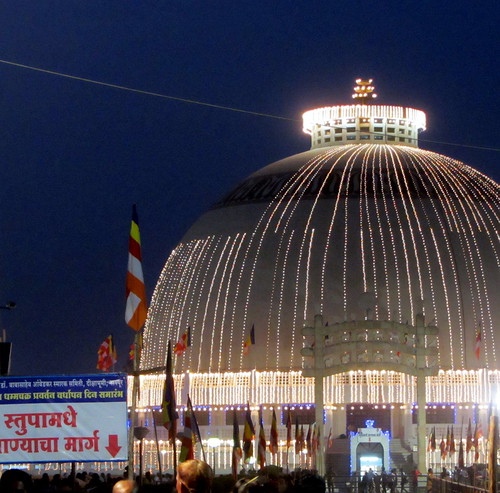
Education was one of the highlights of Ambedkar’s message for his dalit brethren. An entire generation of those converted along with him – called as neo-Buddhists – was exposed to a new thought ‘education can liberate’. For scores of them tormented for various reasons earlier, life and lifestyle changed because of education.
“’Shist and Sanraskshan’ (discipline and security in unity) is what we all learnt from Dr Ambedkar,” said Mujmule Suresh Nagorao, a BA III year student, who also runs a garage at Ukhale Budruk village in tehsil Sonape, district Parbhani. His family had converted to Buddism in 1956 itself but in their own village and not at Deeksha Bhoomi.
But it is not just families such as Dhandes and Nagoraos that visit Deeksha Bhoomi. Earlier, visitors/pilgrims included Ambedkar followers who came mostly from Vidarbha and Marathwada in Maharashtra. But over the years, devout/followers/believers have been coming from across India and abroad – from Tamil Nadu in south to Bihar in north; from Sri Lanka to sometimes even from Japan.
Bhante Sanghbodh and Bodhi Sheelpriya, from Bodh Gaya in Bihar, have been coming for 15 years to Deeksha Bhoomi on Dussehra day. “Buddhism teaches compassion. No wonder more and more people are attracted to this religion,” the monks said referring to almost 10,000-odd people who had taken dhamma deeksha on Tuesday and an equal number or more are set to accept Buddhism on Dussehra day on Thursday.“Not just Hindus, followers of Islam, Christianity and Sikhism too convert to Buddhism,” Bhante Sanghbodh said.
The two monks took deeksha at Deeksha Bhoomi long years ago and were later ordained in the Bhikkhu order at the same place. Affiliated with the All India Bhikkhu Sangha, the monks are also impressed with and proud of the fact that there is huge discipline among the followers despite about 15-lakh odd crowd on the main event day and give credit to the teachings of Buddha for the phenomenon.
Political pilgrims
The place is also offers a good platform for a political pilgrimage for those scouting for dalit votes. The venue sees a grand function each year with almost all leaders from Republican parties attending/addressing the gathering of few lakhs. Almost all years the state’s chief minister too makes it a point to attend the function on the Dussehra day.
In recent times, it was Mayawati, the Bahujan Samaj Party (BSP) supremo, who made a political pilgrimage to this place. The dalit politics had turned a tide when Mayawatibecame the chief minister of Uttar Pradesh. In 2006, speaking on the Dussehra day from this august premises, she vowed to embrace Buddhism when she becomes Prime Minister. Needless to add, subsequent assembly polls have seen her party gaining strong grounds across dalit strongholds in Maharashtra.
Shift from Dussehra to October 14
The place has seen phenomenal increase in number of people visiting before and on the Dussehra day. Although there has been no official record keeping – which is simply impossible as people/devotees throng from all directions and in such large numbers that is not possible to gate keep each one of them – authorities have estimated that average attendance from two days ahead of Dussehra and on the Dussehra day is about 15 lakh.
Numbers have been increasing over the decades but there is a marked difference in terms of spread of visitors. Unlike earlier years, say till 1990s, people thronged the place for almost eight days in the run up to Dusshera and stayed put rendering several restrictions on the movement of Nagpurians and their vehicles. Now, it is mostly a two-day affair ahead of Dussehra day, which of course continues to draw massive crowds.

Two changes have been observed over last decade, especially since 2001 when the memorial stupa was thrown open for public. One is, scores of families and groups of friends make a bee line to Deeksha Bhoomi almost round the year, preferring to visit the place on working day/lesser crowded days rather than facing the hassles on Dussehra day.
But second reason, which is more significant politically too, is since last year (2014), government of Maharashtra has declared October 14 as a public holiday. It has been a long standing demand of some of the Ambedkarites to observe October 14 as the actual anniversary of mass conversion and not Dussehra day, which would mean following a calendar of Hindu religion, which Dr Ambedkar forsake for adopting Buddism.
Now, people start visiting Deeksha Bhoomi since October14 and continue till Dussehra day, spreading out the intensity and lessening the burden on three days in the run up to Dussehra. It is easier not just for visiting pilgrims but also for the administration to manage relatively lesser people over more number of days rather than a bomb of a people on just two days.
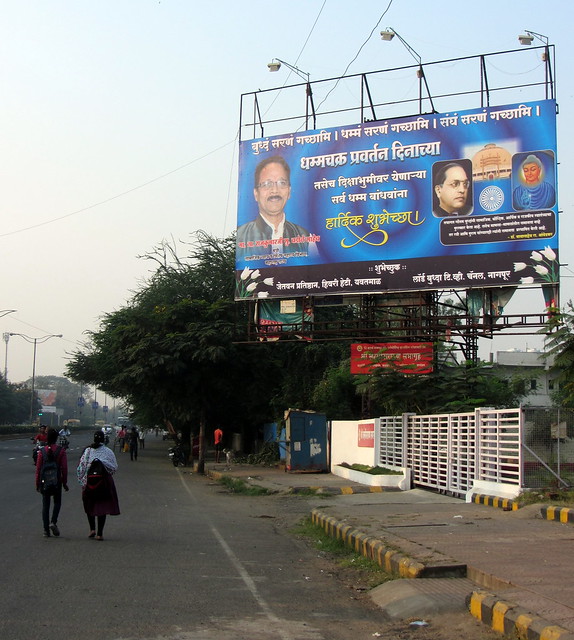
The place is already popular among Dalits, Ambedkarites and Buddhists from other states and even the Maharashtra government has been trying to put this on tourism map.
But tourism or not, it will continue to attract Dalits and Buddha followers. Thousands of them accept dhamma deeksha coinciding with the anniversary of the day of Dr Ambedkar’s conversion. But unlike his conversion – which was a political event that brought about a paradigm change for Dalits and changed the contours of India’s politics vis-à-vis caste – these conversions are not accorded high significance by political pundits and it remains as a routine news in the city supplement of local newspapers.
It will make an interesting wait for the big news … if dalit politics – and by extension Indian political scenario – sees another change again if and when Mayawati converts?
All Photos by Nivedita Khandekar
Nivedita Khandekar is an independent journalist based in Delhi. She writes on environmental, developmental and social issues. She can be reached at [email protected] or follow her on Twitter at @nivedita_Him

